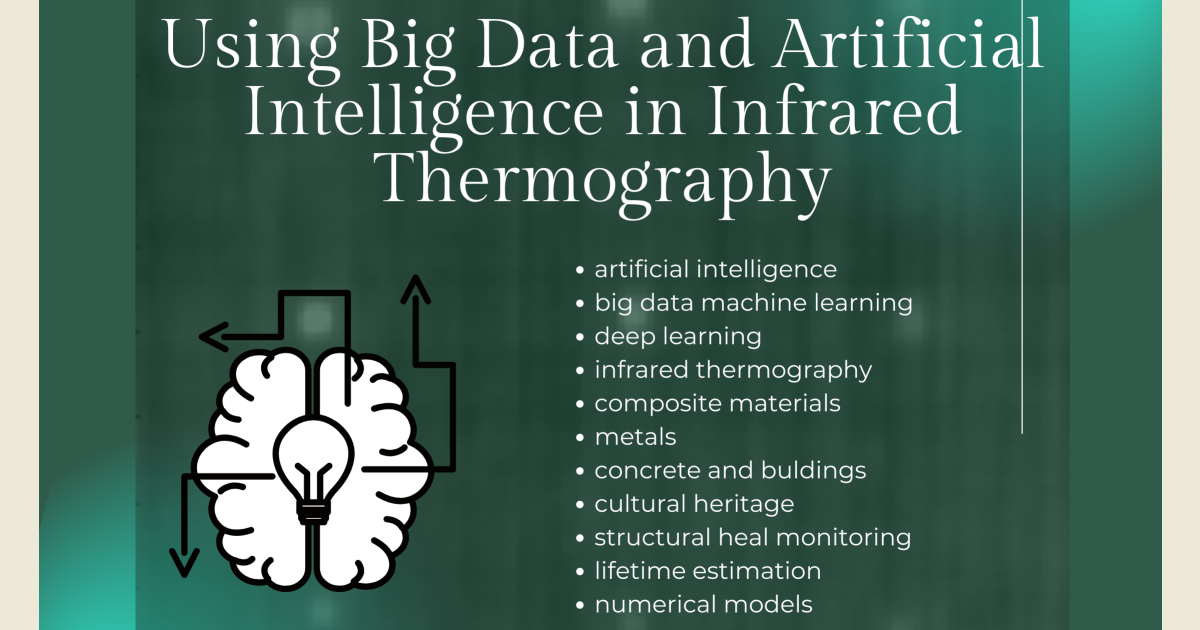Big Data and Artificial Intelligence Applications in Infrared Thermography
A special issue of Applied Sciences (ISSN 2076-3417). This special issue belongs to the section "Optics and Lasers".
Deadline for manuscript submissions: 20 July 2025 | Viewed by 924

Special Issue Editors
Interests: non-destructive testing and evaluation; structural health monitoring; infrared thermography; machine learning; composite materials
Special Issues, Collections and Topics in MDPI journals
2. Computer Vision and Systems Laboratory (CVSL), Department of Electrical and Computer Engineering, Laval University, Quebec City, QC G1V 0A6, Canada
Interests: NDT; diagnostics; non-invasive imaging; composites; structures; thermal imaging; monitoring
Special Issues, Collections and Topics in MDPI journals
Special Issue Information
Dear Colleagues,
Many experimental non-destructive testing methods have been proposed in recent decades to assess the internal structure of components and structures. Infrared thermography currently holds a prestigious place of prominence. It is based on the principle that heat flow in a material is altered by the presence of some types of anomalies, and it usually produces a lot of data. Thousands of images could be acquired during one single experiment. These data must be processed to extract knowledge about the inner structures of the components. In this regard, new applications for artificial intelligence approaches and Big Data analyses focused on material characterization and defect and damage assessment offer great potential.
Machine learning methods are subsets of artificial intelligence that have dramatically evolved over the last few years. They can be used to find solutions to complex problems, for improved signal-to-noise ratio, for interpolation and extrapolation, as well as for prediction and regression. In the past few years, many methods have been developed in the area of image and data science, which can also be applied in other areas, such as non-destructive testing. This Special Issue invites the submission of both review and original research articles related but not limit to the application of artificial intelligence and big data algorithms to enhance data acquired by infrared thermography.
Dr. Henrique Fernandes
Prof. Dr. Nicolas P. Avdelidis
Guest Editors
Manuscript Submission Information
Manuscripts should be submitted online at www.mdpi.com by registering and logging in to this website. Once you are registered, click here to go to the submission form. Manuscripts can be submitted until the deadline. All submissions that pass pre-check are peer-reviewed. Accepted papers will be published continuously in the journal (as soon as accepted) and will be listed together on the special issue website. Research articles, review articles as well as short communications are invited. For planned papers, a title and short abstract (about 100 words) can be sent to the Editorial Office for announcement on this website.
Submitted manuscripts should not have been published previously, nor be under consideration for publication elsewhere (except conference proceedings papers). All manuscripts are thoroughly refereed through a single-blind peer-review process. A guide for authors and other relevant information for submission of manuscripts is available on the Instructions for Authors page. Applied Sciences is an international peer-reviewed open access semimonthly journal published by MDPI.
Please visit the Instructions for Authors page before submitting a manuscript. The Article Processing Charge (APC) for publication in this open access journal is 2400 CHF (Swiss Francs). Submitted papers should be well formatted and use good English. Authors may use MDPI's English editing service prior to publication or during author revisions.
Keywords
- big data
- artificial intelligence
- infrared thermography
Benefits of Publishing in a Special Issue
- Ease of navigation: Grouping papers by topic helps scholars navigate broad scope journals more efficiently.
- Greater discoverability: Special Issues support the reach and impact of scientific research. Articles in Special Issues are more discoverable and cited more frequently.
- Expansion of research network: Special Issues facilitate connections among authors, fostering scientific collaborations.
- External promotion: Articles in Special Issues are often promoted through the journal's social media, increasing their visibility.
- e-Book format: Special Issues with more than 10 articles can be published as dedicated e-books, ensuring wide and rapid dissemination.
Further information on MDPI's Special Issue polices can be found here.






